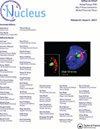慢生根瘤菌和偶氮螺旋菌共接种大豆对生物固氮参数的影响
IF 4.5
3区 生物学
Q3 CELL BIOLOGY
引用次数: 0
摘要
目的评价氮螺旋菌新菌株与大豆慢生根瘤菌共接种的生物固氮(BNF)效果。为此,建立了田间试验,采用以下处理:1 -阴性对照,不接种;2 -正对照200 kg hm -1化学氮肥;3-接种缓生根瘤菌(B);B菌与巴西偶氮螺旋菌共接种;5 -共接种B +株1;6 -共接种B +株2;T7 -共接种B +株3和8 -共接种B +株1、2和3。开花期,每个试验田采5株。评价参数为:主根(NMR, DMMR)、次根(NSR, DMSR)和总根瘤数、干质量(NTR, DMTR);地上部分干质量(DMAP)和根部干质量(DMR)。相对于NSR和NTR,处理4在次生根中提供了更大的根瘤增量,与其他处理相比,处理1的根瘤总量分别为25个和31,87个。NMR治疗3和4是类似于6、7和6,87个结节plant 1,与他人没有从治疗统计diferente Azospirillum菌株(5、6和7)。至于DMMR, DMSR DMTR, 4和3与这些参数和优于治疗(5、6、7和8)。只有DMR和深度贴图化学氮肥(2)站在统计上,与第一个参数统计类似于治疗4和第二治疗8。结果表明,新菌株在BNF参数中表现不突出,与巴西偶氮螺旋菌共接种效果更好。关键词:系选,混合接种,最大甘氨酸本文章由计算机程序翻译,如有差异,请以英文原文为准。
INFLUÊNCIA DA COINOCULAÇÃO DE SOJA COM Bradyrhizobium E DIFERENTES CEPAS DE Azospirillum EM PARÂMETROS DE FIXAÇÃO BIOLÓGICA DE NITROGÊNIO
The objective was to evaluate the efficiency in parameters of biological nitrogen fixation (BNF) of new strains of Azospirillum for coinoculation with Bradyrhizobium in soybean. For this, a fiel experimentw was set up with the following treatments: 1 - negative control without inoculant; 2 - positive control com 200 kg ha-1 of chemical nitrogen fertilizer; 3- inoculation with Bradyrhizobium (B); 4 -coinoculation of B with Azospirillum brasilense; 5 - coinoculation B + strain 1; 6 - coinoculation B + strain 2; T7 - coinoculation B + strain 3 and 8 - coinoculation B + strains 1, 2 and 3. At flowering, 5 plants were collected per experimental plot. The evaluated parameters were: number and dry mass of nodules on the main root (NMR, DMMR), on the secondary roots (NSR, DMSR) and total (NTR, DMTR); dry mass of aerial part (DMAP) and of the root (DMR). In relation to NSR and NTR, treatment 4 provided a greater increment of nodules in the secondary roots and a total of respectively 25 and 31,87 nodules plant-1 in relation to the others tested. For NMR treatments 3 and 4 were similar with means of 6,7 and 6,87 nodules plant-1, not statistically diferente from treatments with others Azospirillum strains (5, 6 and 7). As for DMMR, DMSR and DMTR, 4 and 3 stood out in relation to these parameters and were superior to treatments (5, 6, 7 and 8). Only for DMR and DMAP chemical nitrogen fertilization (2) stood out statistically, with the first parameter statistically similar to treatment 4 and second to treatment 8. It can be concluded that the new strains did not stand out in the parameters of BNF, with coinoculation with Azospirillum brasilense more efficient. Keywords: Lineage selection, Mixed inoculation, Glycine max.
求助全文
通过发布文献求助,成功后即可免费获取论文全文。
去求助
来源期刊

Nucleus
CELL BIOLOGY-
CiteScore
5.60
自引率
5.40%
发文量
16
审稿时长
13 weeks
期刊介绍:
Nucleus is a fully open access peer-reviewed journal. All articles will (if accepted) be available for anyone to read anywhere, at any time immediately on publication.
Aims & Scope: The eukaryotic cell nucleus is more than a storage organelle for genomic DNA. It is involved in critical steps of cell signaling and gene regulation, as well as the maintenance of genome stability, including DNA replication and DNA damage repair. These activities heavily depend on the spatial and temporal “functional” organization of the nucleus and its integration into the complex meshwork of cellular scaffolding.
Nucleus provides a platform for presenting and discussing cutting-edge research on all aspects of biology of the cell nucleus. It brings together a multidisciplinary community of scientists working in the areas of:
• Nuclear structure and dynamics
• Subnuclear organelles
• Chromatin organization
• Nuclear transport
• DNA replication and DNA damage repair
• Gene expression and RNA processing
• Nucleus in signaling and development
Nucleus offers a variety of paper formats including:
• Original Research articles
• Short Reports
• Reviews
• Commentaries
• Extra Views
• Methods manuscripts.
 求助内容:
求助内容: 应助结果提醒方式:
应助结果提醒方式:


